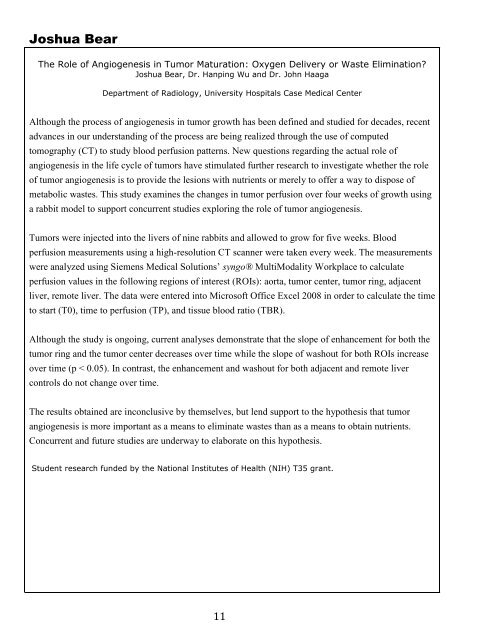student research day - Case Western Reserve University School of ...
student research day - Case Western Reserve University School of ...
student research day - Case Western Reserve University School of ...
Create successful ePaper yourself
Turn your PDF publications into a flip-book with our unique Google optimized e-Paper software.
Joshua Bear<br />
The Role <strong>of</strong> Angiogenesis in Tumor Maturation: Oxygen Delivery or Waste Elimination?<br />
Joshua Bear, Dr. Hanping Wu and Dr. John Haaga<br />
Department <strong>of</strong> Radiology, <strong>University</strong> Hospitals <strong>Case</strong> Medical Center<br />
Although the process <strong>of</strong> angiogenesis in tumor growth has been defined and studied for decades, recent<br />
advances in our understanding <strong>of</strong> the process are being realized through the use <strong>of</strong> computed<br />
tomography (CT) to study blood perfusion patterns. New questions regarding the actual role <strong>of</strong><br />
angiogenesis in the life cycle <strong>of</strong> tumors have stimulated further <strong>research</strong> to investigate whether the role<br />
<strong>of</strong> tumor angiogenesis is to provide the lesions with nutrients or merely to <strong>of</strong>fer a way to dispose <strong>of</strong><br />
metabolic wastes. This study examines the changes in tumor perfusion over four weeks <strong>of</strong> growth using<br />
a rabbit model to support concurrent studies exploring the role <strong>of</strong> tumor angiogenesis.<br />
Tumors were injected into the livers <strong>of</strong> nine rabbits and allowed to grow for five weeks. Blood<br />
perfusion measurements using a high-resolution CT scanner were taken every week. The measurements<br />
were analyzed using Siemens Medical Solutions’ syngo® MultiModality Workplace to calculate<br />
perfusion values in the following regions <strong>of</strong> interest (ROIs): aorta, tumor center, tumor ring, adjacent<br />
liver, remote liver. The data were entered into Micros<strong>of</strong>t Office Excel 2008 in order to calculate the time<br />
to start (T0), time to perfusion (TP), and tissue blood ratio (TBR).<br />
Although the study is ongoing, current analyses demonstrate that the slope <strong>of</strong> enhancement for both the<br />
tumor ring and the tumor center decreases over time while the slope <strong>of</strong> washout for both ROIs increase<br />
over time (p < 0.05). In contrast, the enhancement and washout for both adjacent and remote liver<br />
controls do not change over time.<br />
The results obtained are inconclusive by themselves, but lend support to the hypothesis that tumor<br />
angiogenesis is more important as a means to eliminate wastes than as a means to obtain nutrients.<br />
Concurrent and future studies are underway to elaborate on this hypothesis.<br />
Student <strong>research</strong> funded by the National Institutes <strong>of</strong> Health (NIH) T35 grant.<br />
11
















